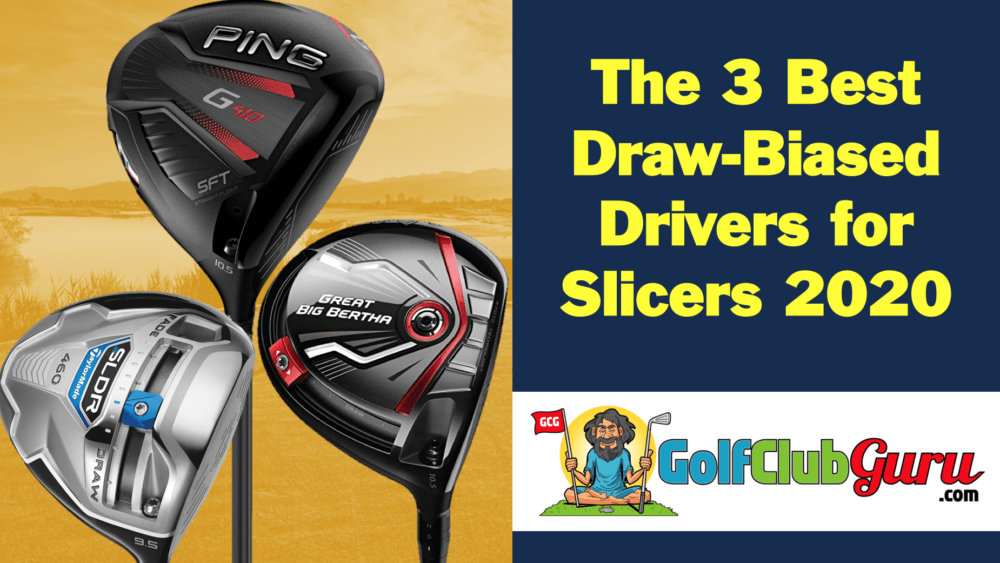Let me be very clear here: I do NOT encourage anyone to “buy” a quick fix like this. I’m a big proponent of finding a great PGA instructor to slowly fix your swing problems one step at a time. When you are pleased with your golf swing as a whole (your setup, your swing path, your impact position, etc), you should then get fitted from a professional to find the best driver shaft and club head for YOUR swing.
If your swing is incredibly over the top with a huge open club face at impact, the most draw-biased driver in the world isn’t doing to fix you.
With that being said, there is NOTHING wrong with getting all of the help that you can. If one driver can naturally lead to you closing the club face at impact, it would be dumb to ignore that. I just don’t want any reader to think that one of these drivers that I mention will instantly fix your slice.
There is one thing that all draw-biased drivers have in common. They have more weight towards the heel of the club, compared to the toe of the club. That means that it’s easier to square the club face up at impact, as there is less weight on the toe that your hands have to turn over throughout impact. No one wants to think about a swing fix during the split second of impact. A draw-biased driver will help the club face square up NATURALLY, without you having to think about anything. You still need to learn how to properly release the club through impact, though…. draw biased drivers just make the job easier. That’s it.
Here’s a good picture (below) of what we are going to be talking about in this article. I’ll suggest three options, depending on your budget.
Now, you might be asking, wait can I just turn my current driver into a “draw-biased” driver? Well, you can put lead tape near the heel of your driver. However, you’ll be messing with the overall swing weight of the driver, which will impact performance and feel. Plus, you’re now swinging a heavier club head, which will result in a decrease in swing speed and driving distance as a result. These three drivers were made specifically to fight that dreaded slice. Basically, weight was taken from the toe and put near the heel instead, which won’t effect the overall swing weight of the club. Or, a driver with adjustable weights that can slide towards the heel will also work, which we will talk more about below.
Best Overall: PING G410 SFT Driver
The Ping G410 SFT (Straight Flight Technology) driver is the only one of the three in this article that isn’t adjustable. This driver was designed to be draw-biased without any adjustment needed. The heel-side weight is 50% heavier than the toe side, which is a major difference that encourages a square club face at impact.
The original Ping G410 driver has been the most popular driver of the year so far. Adding in the extra heel weight makes this the absolute BEST overall draw-biased driver for slicers… if budget isn’t a concern.
I know we are just talking about getting rid of slices here, but this Ping G410 SFT driver is simply an awesome all around driver. Great feel & sound at impact. Plenty of forgiveness. Plenty of distance. I truly can’t think of a better driver for slicers if you want the cream of the crop.
- Best for: slicer who can afford the best of the best
- Pros: Great all around driver, not just for getting rid of that damn slice
- Cons: The most expensive of the three in this article… by far!
Best Value: Callaway Great Big Bertha
The Callaway Great Big Bertha driver is an adjustable driver that offers a sliding weight across the sole of the driver head. When you move that weight towards the heel, you effectively turn the driver into a draw-biased driver.
When it was first released about 5 years ago, it was the hottest driver on the market. Callaway likes their drivers just like you do: long and straight. The great thing about the Callaway Great Big Bertha driver is that you can always “undo” the draw bias when needed by moving the weight back to a neutral position or even to the fade-biased position near the toe of the club.
Please, please, please don’t get too attached to changing the weight around too often. This is golf. The goal is to just get the ball into that little hole in as few strokes as possible. It’s not a game where you should be moving a weight half an inch back and forth each day to dial in your drives. Remember: it really is the indian, not the arrow.
- Best for: slicer or fader of the golf ball that wants the best value equipment
- Pros: Can move the weight back to a neutral position once you finally fix your swing that is causing the slices to start with. Great value around $150 for a used one in good condition.
- Cons: Can be hard to find one in great condition, as they get bought up pretty quickly.
Best Under $100: TaylorMade SLDR
There is something about the $100 threshold that really gets me going. Everything in my bag currently was purchased for less than $100 each, and I’m sure many guys and gals out there are trying to do the same. If you are, consider the TaylorMade SLDR driver. Yep, that club that took the industry by storm many years ago. Just like the Callaway Great Big Bertha, the TaylorMade SLDR offers a sliding weight that allows you to put more weight towards the heel of the club.
The reviews from the TaylorMade SLDR have always been a little iffy. Some find that they create way too much spin on their drives, while others have glowed at their incredible results. Just remember that you NEED to increase the loft on this driver compared to what you are used to. They were made so that you can increase the loft and therefore slightly increase the forgiveness (easier to hit a more lofted club in general).
For less than $100 for a decent condition used club, you really can’t go wrong here.
- Best for: a golfer who is low on funds but tired of slicing
- Pros: Can “undo” the draw bias by moving the weight back to normal. Allows you to increase your loft and therefore improve forgiveness slightly.
- Cons: Some find that the club head is simply too “spinny”







